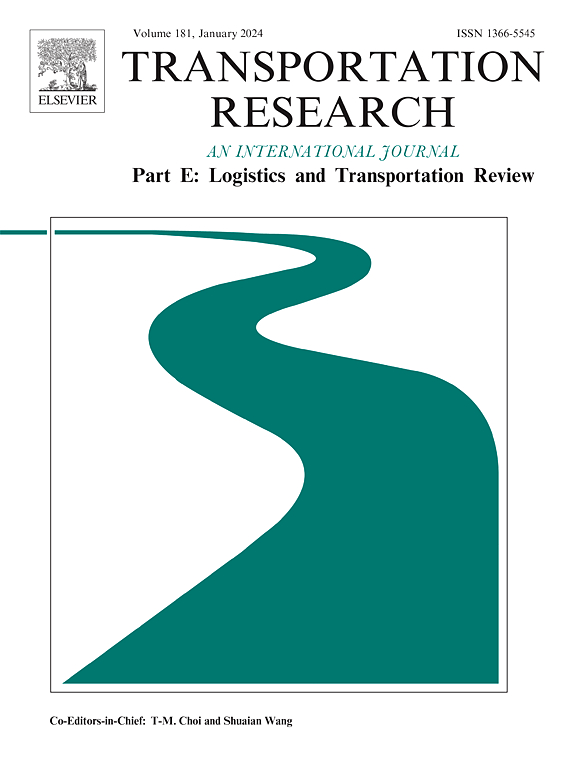System dynamics in railway project appraisal: Assessing student productivity and wider economic benefits in the knowledge economy
IF 8.3
1区 工程技术
Q1 ECONOMICS
Transportation Research Part E-Logistics and Transportation Review
Pub Date : 2025-07-17
DOI:10.1016/j.tre.2025.104325
引用次数: 0
Abstract
Rail projects require substantial long-term investments, making comprehensive project appraisal essential. Traditional cost-benefit analysis (CBA) emphasizes direct benefits but often overlooks wider economic benefits (WEB) like productivity gains and human capital development within the knowledge economy. Even when WEB considered, most studies rarely capture the feedback loops between different benefits over time, limiting comprehensive evaluation. To address these gaps, this paper develops a system dynamics (SD)-based WEB evaluation framework, applying it to the Shatin to Central Link project in Hong Kong, which connects a major university to the local transit network. The model uses student salary as a proxy of productivity, reflecting indirect economic benefits tied to human capital enhancement. Based on survey data, the results show increased student productivity contributes a cumulative impact equivalent to 1.60% of total WEB value over 50 years. The analysis reveals significant long-term gains, with profitability increasing from HK$35.79 billion to HK$42.20 billion and the investment payback period shortening by 0.42 years to 13.86 years when feedback loops are considered versus traditional CBA. These findings highlight the cumulative effects from the interactions among benefits and the reinforcing relationship between infrastructure and productivity in driving economic growth. While this case focuses on one university, the framework can be extended to assess wider regional impacts. The model’s generalizability is discussed through feature customization, integrated impacts, and multi-stakeholder perspectives. This research demonstrates that the SD approach enhances WEB analysis, overcoming limitations of CBA and offering actionable insights for investment decisions that promote sustainable, knowledge-based urban development.
铁路项目评估中的系统动力学:在知识经济中评估学生生产力和更广泛的经济效益
铁路项目需要大量的长期投资,因此全面的项目评估至关重要。传统的成本效益分析(CBA)强调直接效益,但往往忽视了知识经济中更广泛的经济效益,如生产力的提高和人力资本的发展。即使考虑到这一点,大多数研究也很少捕捉到不同利益之间随时间的反馈循环,从而限制了全面的评估。为了解决这些差距,本文开发了一个基于系统动力学(SD)的WEB评估框架,并将其应用于香港的沙田至中环线项目,该项目将一所主要大学与当地的交通网络连接起来。该模型使用学生工资作为生产率的代表,反映了与人力资本增强相关的间接经济效益。根据调查数据,结果表明,在50年的时间里,学生生产力的提高对WEB总价值的累计影响相当于1.60%。分析显示,与传统CBA相比,考虑反馈循环后,盈利能力从357.9亿港元增加到42.2亿港元,投资回收期缩短0.42年至13.86年。这些发现强调了利益之间的相互作用以及基础设施与生产力之间的强化关系在推动经济增长方面的累积效应。虽然本案例侧重于一所大学,但该框架可以扩展到评估更广泛的区域影响。通过特征定制、综合影响和多利益相关者的视角讨论了模型的可泛化性。本研究表明,可持续发展方法增强了WEB分析,克服了CBA的局限性,并为促进可持续、知识型城市发展的投资决策提供了可操作的见解。
本文章由计算机程序翻译,如有差异,请以英文原文为准。
求助全文
约1分钟内获得全文
求助全文
来源期刊
CiteScore
16.20
自引率
16.00%
发文量
285
审稿时长
62 days
期刊介绍:
Transportation Research Part E: Logistics and Transportation Review is a reputable journal that publishes high-quality articles covering a wide range of topics in the field of logistics and transportation research. The journal welcomes submissions on various subjects, including transport economics, transport infrastructure and investment appraisal, evaluation of public policies related to transportation, empirical and analytical studies of logistics management practices and performance, logistics and operations models, and logistics and supply chain management.
Part E aims to provide informative and well-researched articles that contribute to the understanding and advancement of the field. The content of the journal is complementary to other prestigious journals in transportation research, such as Transportation Research Part A: Policy and Practice, Part B: Methodological, Part C: Emerging Technologies, Part D: Transport and Environment, and Part F: Traffic Psychology and Behaviour. Together, these journals form a comprehensive and cohesive reference for current research in transportation science.

 求助内容:
求助内容: 应助结果提醒方式:
应助结果提醒方式:


